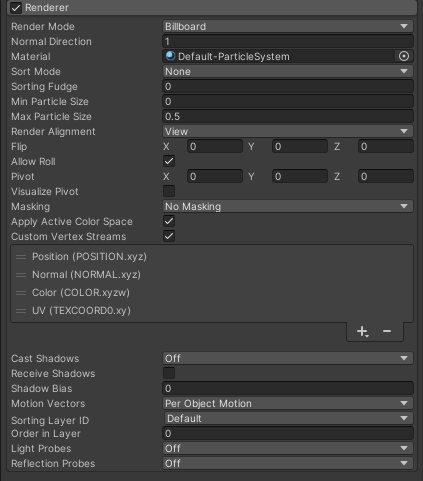渲染器 (Renderer) 模块参考
渲染器模块的设置决定了粒子的图像或网格 (Mesh) 如何被其他粒子变换、着色和过度绘制。

属性
对于本节中的某些属性,可以使用不同的模式来设置它们的值。关于可用模式的详细信息,请参阅随时间变化的属性。
|属性:||||功能:|
|:—|:—|:—|:—|:—|
|Render Mode||||Unity 如何从图形图像(或网格)生成渲染图像。有关更多信息,请参阅粒子渲染和着色。 |
||Billboard|||Unity 将粒子呈现为公告牌并面向您在渲染对齐 (Render Alignment) 中指定的方向。 |
||Stretched Billboard|||粒子面向摄像机 (Camera),但会应用各种可能的缩放选项。 |
|
| |Camera Scale||仅当使用拉伸公告牌 (Stretched Billboard) 渲染模式时,此设置才可用。
根据摄像机运动拉伸粒子。将此值设置为 0 可禁用摄像机运动拉伸。|
|
| |Velocity Scale||仅当使用拉伸公告牌 (Stretched Billboard) 渲染模式时,此设置才可用。
根据粒子速度按比例拉伸粒子。将此值设置为 0 可禁用基于速度的拉伸。|
|
| |Length Scale||仅当使用拉伸公告牌 (Stretched Billboard) 渲染模式时,此设置才可用。
沿着粒子的速度方向根据粒子当前大小按比例拉伸粒子。将此值设置为 0 会使粒子消失,相当于 0 长度。|
|
| |Freeform Stretching||仅当使用拉伸公告牌 (Stretched Billboard) 渲染模式时,此设置才可用。
指示粒子是否应使用自由形式拉伸。通过这种拉伸行为,当正面查看粒子时,粒子不会变薄。|
|
| |Rotate With Stretch||仅当使用拉伸公告牌 (Stretched Billboard) 渲染模式时,此设置才可用。
指示是否根据粒子的拉伸方向旋转粒子。这是在其他粒子旋转的基础上添加的。此属性仅在自由拉伸 (Freeform Stretching) 启用时有效。如果禁用自由拉伸 (Freeform Stretching),粒子总是根据它们拉伸的方向旋转,即使随拉伸旋转 (Rotate With Stretch) 已禁用也是如此。|
||Horizontal Billboard|||粒子平面与 XZ“地板”平面平行。|
||Vertical Billboard|||粒子在世界 Y 轴上直立,但转向面向摄像机。|
||Mesh|||Unity 从 3D 网格而非从公告牌渲染粒子。有关网格渲染 (Mesh Render) 模式特定设置的更多信息,请参阅粒子渲染和着色。|
|
| |Mesh Distribution||指定 Unity 用于将网格随机分配给粒子的方法。
仅当使用网格渲染模式时,此设置才可用。|
|
| |
|Uniform Random|Unity 随机将网格分配给具有均匀权重的粒子。粒子系统作为一个整体在任何给定时刻都应包含大致相等数量的各种可能的网格。
仅当使用网格渲染模式时,此设置才可用。|
|
| |
|Non-uniform Random|Unity 会随机将网格分配给粒子,每个网格的权重由用户定义。
启用此设置后,渲染器 (Renderer) 模块检视面板 (Inspector) 窗口将显示网格列表和列表中每个网格的网格权重 (Mesh Weightings) 字段。您可以使用网格权重 (Mesh Weightings) 字段来控制 Unity 将每个网格分配给粒子的频率。
仅当使用网格渲染模式时,此设置才可用。|
|
| |Mesh Weightings||控制 Unity 将此网格分配给粒子的可能性。权重是相对的;Unity 会给一个网格分配两倍于另一个网格的权重,而不管它们的绝对值是多少。有关更多信息,请参阅粒子渲染和着色。
仅当使用网格渲染模式并且网格分配 (Mesh Distribution) 属性设置为“非均匀随机 (Non- uniform Random)”时,此设置才可用。|
||None|||Unity 不会渲染任何粒子。使用轨迹 (Trails) 模块时,如果只想渲染轨迹并隐藏默认粒子渲染,则可使用此属性。|
|Normal Direction||||指定计算公告牌的光照的方法。值为 0 表示 Unity 计算光照时将公告牌视为一个球体。这使得公告牌看起来更像一个球体。值为 1 表示 Unity 计算光照时将公告牌视为一个平面四边形。
仅当使用公告牌渲染模式之一时,此属性才可用:公告牌 (Billboard)、拉伸公告牌 (Stretched Billboard)、水平公告牌 (Horizontal Billboard) 或垂直公告牌 (Vertical Billboard)。 |
|Material||||Unity 用于渲染粒子的材质。|
|Trail Material||||Unity 用于渲染粒子轨迹的材质。
仅当启用了轨迹 (Trails) 模块时,此选项才可用。|
|Sort Mode||||Unity 使用粒子系统绘制和覆盖粒子的顺序。|
||None|||启用此设置后,Unity 不会对粒子进行排序。|
||By Distance|||根据与活动摄像机的距离对系统中的粒子进行排序。Unity 会将距离摄像机较近的粒子渲染到距离较远的粒子之上。通过设置旋转摄像机时,粒子的顺序不会改变。|
||Oldest in Front|||Unity 会将粒子系统中存在时间最长的粒子渲染在最前面。|
||Youngest in Front|||Unity 会将粒子系统中存在时间最短的粒子渲染在最前面。|
||By Depth|||Unity 根据粒子与摄像机近平面的距离来渲染粒子。使用此设置旋转摄像机时,粒子的顺序可能会发生变化。|
|Sorting Fudge||||粒子系统排序的偏差。数值越低,Unity 在其他透明游戏对象(包括其他粒子系统)上绘制粒子系统的几率相对越大。此设置只影响场景中出现的整个粒子系统,而不会对系统中的单个粒子进行排序。|
|Min Particle Size||||最小粒子大小(无论其他设置如何),表示为视口大小的一个比例。
仅当使用公告牌渲染模式之一时,此属性才可用:公告牌 (Billboard)、拉伸公告牌 (Stretched Billboard)、水平公告牌 (Horizontal Billboard) 或垂直公告牌 (Vertical Billboard)。|
|Max Particle Size||||最大粒子大小(无论其他设置如何),表示为视口大小的一个比例。
仅当使用公告牌渲染模式之一时,此属性才可用:公告牌 (Billboard)、拉伸公告牌 (Stretched Billboard)、水平公告牌 (Horizontal Billboard) 或垂直公告牌 (Vertical Billboard)。|
|Render Alignment||||此属性决定粒子公告牌面向的方向。|
||View|||粒子面向摄像机平面。|
||World|||粒子与世界轴对齐。|
||Local|||粒子与其游戏对象的变换组件对齐。|
||Facing|||粒子面向活动摄像机游戏对象中的变换组件所定义的直接位置。|
||Velocity|||粒子面向与其速度矢量相同的方向。|
|Enable Mesh GPU Instancing||||仅当使用网格渲染模式时,此属性才可用。
此属性控制 Unity 是否使用 GPU 实例化渲染粒子系统。这需要使用兼容的着色器。有关更多信息,请参阅粒子网格 GPU 实例化。|
|Flip||||在指定轴上对一定比例的粒子进行镜像化处理。较高的值会翻转更多的粒子。|
|Allow Roll||||控制面向摄像机的粒子是否可以围绕摄像机的 Z 轴旋转。禁用此属性对于__ VR__虚拟现实。更多信息
See in Glossary 应用特别有用,因为在此应用中 HMD(头戴式显示器)滚动可能会给粒子系统带来不必要的粒子旋转。 |
|Pivot||||修改旋转粒子的中心轴心点。此值是粒子大小的乘数。|
|Visualize Pivot||||在场景 (Scene) 视图中预览粒子轴心点。|
|Masking||||设置粒子系统渲染的粒子在与精灵遮罩交互时的行为方式。|
||No Masking|||粒子系统不与场景中的任何精灵遮罩交互。这是默认选项。|
||Visible Inside Mask|||粒子在由精灵遮罩覆盖的地方是可见的,而在遮罩外部不可见。|
||Visible Outside Mask|||粒子在精灵遮罩外部是可见的,而在遮罩内部不可见。精灵遮罩会隐藏其覆盖的粒子部分。|
|Apply Active Color Space||||在线性颜色空间中渲染时,系统会在将粒子颜色上传到 GPU 之前从伽马空间转换粒子颜色。|
|Custom Vertex Streams||||配置材质的顶点着色器中可用的粒子属性。有关更多信息,请参阅粒子系统顶点流和标准着色器支持。|
|Cast Shadows||||如果启用此属性,阴影投射光源照在粒子系统上时将产生阴影。|
||On|||为此粒子系统启用阴影。|
||Off|||禁用此粒子系统的阴影。|
||Two-Sided|||选择双面 (Two Sided),以允许从网格的任一侧投射阴影。启用此属性时不考虑背面剔除。|
||Shadows Only|||选择仅阴影 (Shadows Only) 使阴影可见,但网格本身不可见。|
|Shadow Bias||||沿光源方向移动阴影。这样可以消除因使用公告牌模拟体积而导致的阴影瑕疵。|
|Motion Vectors||||设置是否使用运动矢量来跟踪此粒子系统的变换组件从一帧到下一帧的每像素屏幕空间运动。
注意:并非所有平台都支持运动矢量功能。请参阅 SystemInfo.supportsMotionVectors 以了解更多信息。|
||Camera Motion Only|||仅使用摄像机移动来跟踪运动。|
||Per Object Motion|||使用特定通道来跟踪此渲染器的运动。|
||Force No Motion|||不跟踪运动。|
|Receive Shadows||||决定系统中的粒子是否可以从其他来源接收阴影。只有不透明材质才能接受阴影。|
|Sorting Layer ID||||渲染器排序图层的名称。|
|Order in Layer||||此渲染器在排序图层中的顺序。|
|Light Probes||||基于探针的光照插值模式。|
|Reflection Probes||||如果启用此属性,并且如果场景 (Scene) 中存在反射探针,则 Unity 会从最近的反射探针中为该游戏对象分配一个反射纹理,并将该纹理设置为内置着色器统一变量。|
|Anchor Override||||使用光照探针 (Light Probe) 或反射探针 (Reflection Probe) 系统时用于确定插值位置的变换。|